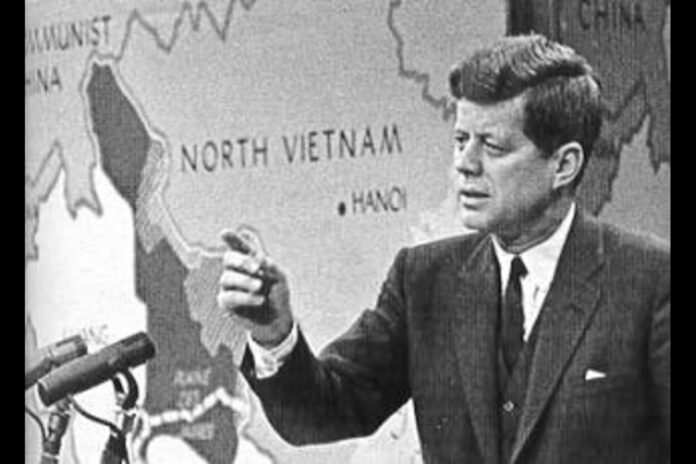The release of thousands of previously classified documents related to President John F. Kennedy’s assassination has sparked renewed interest in the case.
Researchers and historians are analyzing these files for new insights into one of America’s most debated events. While the documents provide additional details, they do not fully resolve the long-standing mysteries surrounding President John F. Kennedy’s 1963 assassination in Dallas.
The newly available records include materials that were once heavily redacted or completely withheld. These files shed more light on the extent of the CIA’s surveillance of Lee Harvey Oswald, the man accused of killing Kennedy. Despite these revelations, many questions remain unanswered, and conspiracy theories continue to thrive.
A government investigation in the 1960s determined that Oswald acted alone when he fired shots at Kennedy’s motorcade. Oswald, a former Marine who had previously defected to the Soviet Union, was arrested but never stood trial because he was murdered two days later. Even after 60 years, debates persist, and these newly released files are unlikely to put an end to them.
1) More CIA Surveillance Details on Oswald
One of the key revelations in the new documents is the extent of the CIA’s interest in Oswald before the assassination. Journalist Jefferson Morley, an expert on the case, says these files confirm that Oswald was under CIA scrutiny long before the shooting. However, this has only become widely known in recent years.
While many of these documents had been made public before, they now appear in a more complete form. Researchers continue to examine them, but so far, no major breakthroughs have emerged. Even so, historians consider this the most significant release of JFK-related documents since the 1990s.
The files provide new details about Oswald’s trip to Mexico City in September 1963, just weeks before Kennedy was assassinated. The CIA monitored him during this visit and intercepted phone calls between him and a Soviet embassy guard. In one call, Oswald identified himself, and some reports suggest he may have mentioned killing Kennedy.
A 1975 CIA memo, now fully declassified, downplays the agency’s awareness of Oswald’s actions in Mexico. However, the new files confirm that U.S. intelligence agencies had significant knowledge of Oswald’s movements prior to the assassination. This raises further speculation about how closely he was being watched and whether officials could have prevented the attack.
2) CIA Intelligence Methods Revealed
Some of the newly unsealed documents provide insight into Cold War intelligence-gathering tactics. A previously censored memo from Kennedy aide Arthur Schlesinger highlights concerns about the CIA’s growing influence over U.S. foreign policy.
Schlesinger warned Kennedy that the agency maintained a strong presence in U.S. embassies, even in allied nations like France. Although not directly tied to the assassination, this memo reveals tensions between Kennedy and intelligence agencies. Some experts believe this document reflects broader issues with the CIA’s operations at the time.
Villanova University professor David Barrett, an expert on intelligence agencies, considers this document release an important step toward transparency. However, some sections remain redacted, suggesting that certain information is still being withheld from the public.
One declassified record describes how the CIA used fluoroscopic scanning—an X-ray technique—to detect hidden microphones in offices suspected of being bugged. Another file details a secret system for tagging wiretapped phone booths with ultraviolet-visible paint, allowing agents to track conversations.
Among the newly unredacted names in these documents is James McCord, who later became infamous for his role in the Watergate scandal. McCord’s involvement in intelligence operations long before the Nixon-era break-in highlights the deep connections between Cold War espionage and later political scandals.
3) Old Conspiracy Theories Resurface
The release of these files has revived some of the most well-known conspiracy theories surrounding Kennedy’s assassination. Social media users quickly latched onto certain documents, claiming they provide new proof of CIA involvement. However, many of these claims rely on information that has been available for years.
One widely shared story involves Gary Underhill, a former military intelligence officer. Underhill allegedly told acquaintances that rogue CIA agents were behind Kennedy’s assassination. He was found dead in 1964, and his death was officially ruled a suicide. Despite this, some continue to question the circumstances surrounding it.
A seven-page CIA memo mentioning Underhill recently went viral, but most of its contents had already been declassified in 2017. The newly unredacted sections contain only minor details and do not significantly change what was already known about the case.
The theory about Underhill’s accusations is based on secondhand accounts published after his death. No direct evidence supports his claims, yet the story continues to spread online. The latest document release has also fueled renewed discussion of other unverified assassination theories.
Although some believe these files contain new proof of a larger conspiracy, experts caution that the documents do not provide definitive answers. Most of the long-standing theories remain unproven, and speculation is unlikely to end anytime soon.
4) Are These the Final Files?
A law passed in 1992 required the release of all JFK-related documents within 25 years, but it allowed for exceptions based on national security concerns. Since then, multiple administrations have gradually declassified more records, including batches released by Presidents Trump and Biden.
Before this latest disclosure, Trump claimed he instructed officials not to redact any information. However, some files still contain blacked-out sections. Despite this, experts agree that this release represents progress toward greater transparency.
Researcher Jefferson Morley believes additional documents remain hidden. Some are stored in the National Archives, while others are still classified by the CIA and FBI. These undisclosed files could contain more information about Kennedy’s assassination or intelligence operations from that era.
Future releases may also include documents related to the assassinations of Robert F. Kennedy and Martin Luther King Jr. However, even if more records are made public, key questions surrounding JFK’s murder will likely remain.
Villanova historian David Barrett argues that high-profile assassinations always lead to ongoing debates and speculation. He believes no document release—no matter how complete—will ever eliminate conspiracy theories surrounding the case. For now, the mystery of JFK’s assassination remains as compelling as ever.


